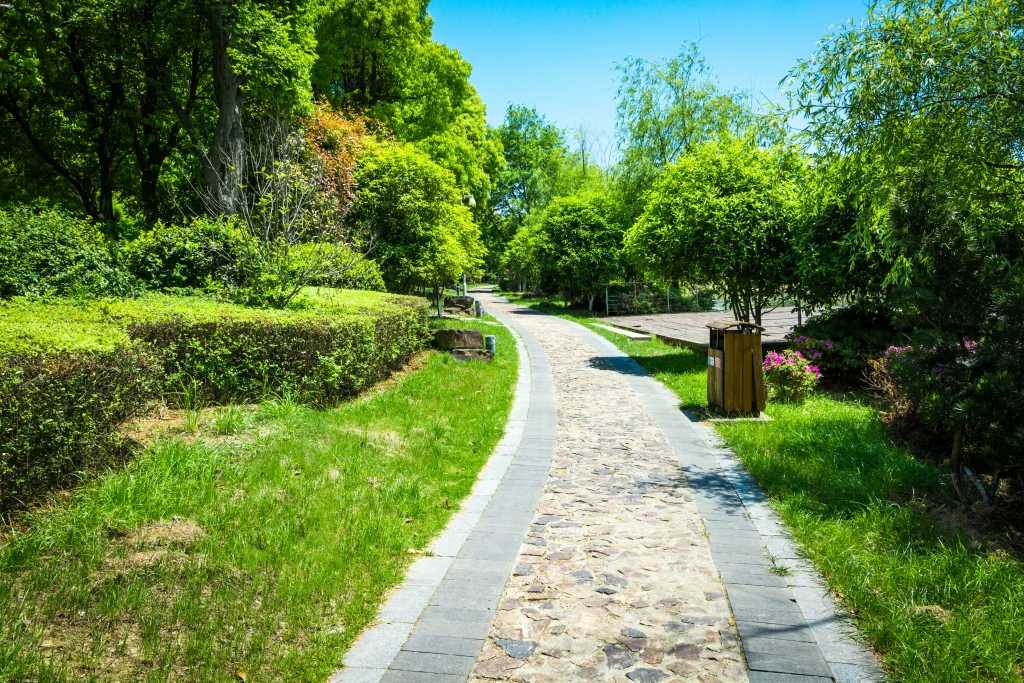Watering your lawn at the right time can make a world of difference in achieving a lush, green yard. The best time to water lawn isn’t just about convenience – it directly impacts grass growth, water efficiency, and overall lawn health. Yet, many homeowners struggle with finding the right schedule, often watering at times that lead to water waste or increased disease risk.
In this article, we’ll dive into the ideal watering times, methods, and essential rules for effective lawn care. For Denver homeowners seeking professional assistance, Mile High Lifescape is the trusted name in tree and lawn care, offering expert guidance and services to keep your lawn thriving. Ready to discover the best time to water lawn for a healthier lawn? Let’s get started!
Why Timing Matters When Watering Your Lawn
Watering your lawn at the wrong times can cause problems like wasting water, not giving your lawn enough hydration, or even leading to lawn diseases.
For example, many people water their lawns in the middle of the day or late in the afternoon. While this might seem like a good time, it actually causes the water to evaporate too quickly, so the grass doesn’t get enough water.
Watering late in the evening can also cause problems because the water stays on the grass overnight. This extra moisture can lead to lawn diseases.
The best time to water lawn is early in the morning. The cooler temperatures in the morning help the water soak into the grass before it evaporates, and it gives your lawn enough time to dry out before evening. This helps keep your lawn healthy and strong!
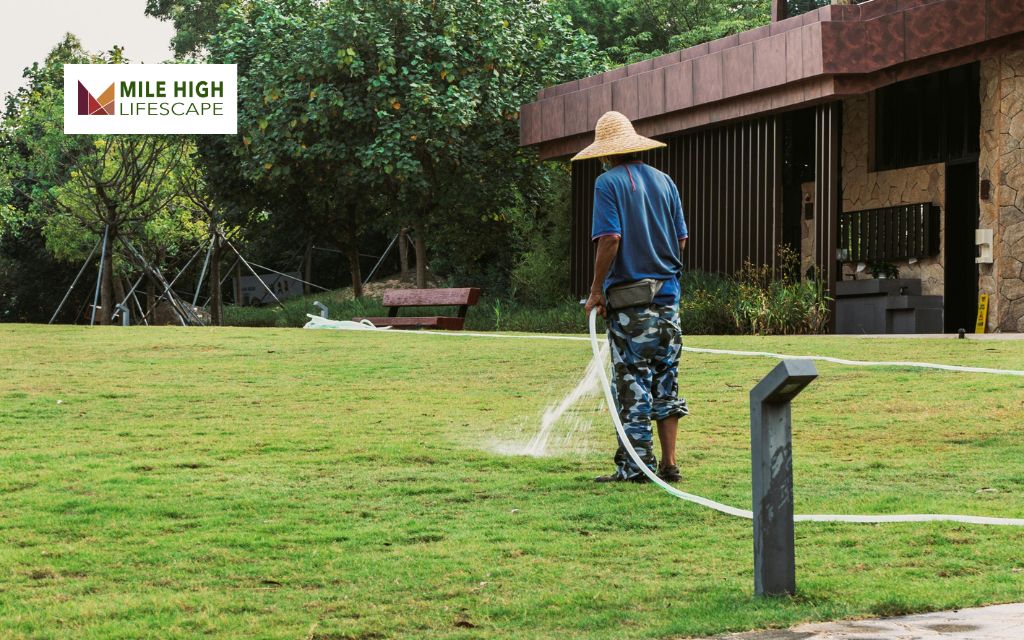
What is The Best Time to Water Lawn?
The best time to water lawn is early in the morning, between 5 a.m. and 9 a.m. This is when there’s less wind, and the water won’t evaporate as quickly. Watering at this time helps the water soak deep into the soil, reaching the roots. Plus, any water left on the grass dries quickly, which helps prevent lawn diseases like fungus.
If you can’t water in the morning, the next best time to water lawn is around 6 p.m., in the early evening. But watering too late at night can be risky because the water stays on the grass blades for a long time without the sun to help dry it, which can cause problems like brown spots and fungus.
A good option for evening watering is using a drip irrigation system. It delivers water straight to the roots, avoiding the leaves and reducing the chances of disease. But overall, watering in the morning is still the best for keeping your lawn healthy and happy.
Pro tip: Avoid watering between 10 a.m. and 4 p.m. because the heat makes most of the water evaporate before it soaks in. This wastes water and leaves your lawn thirsty.
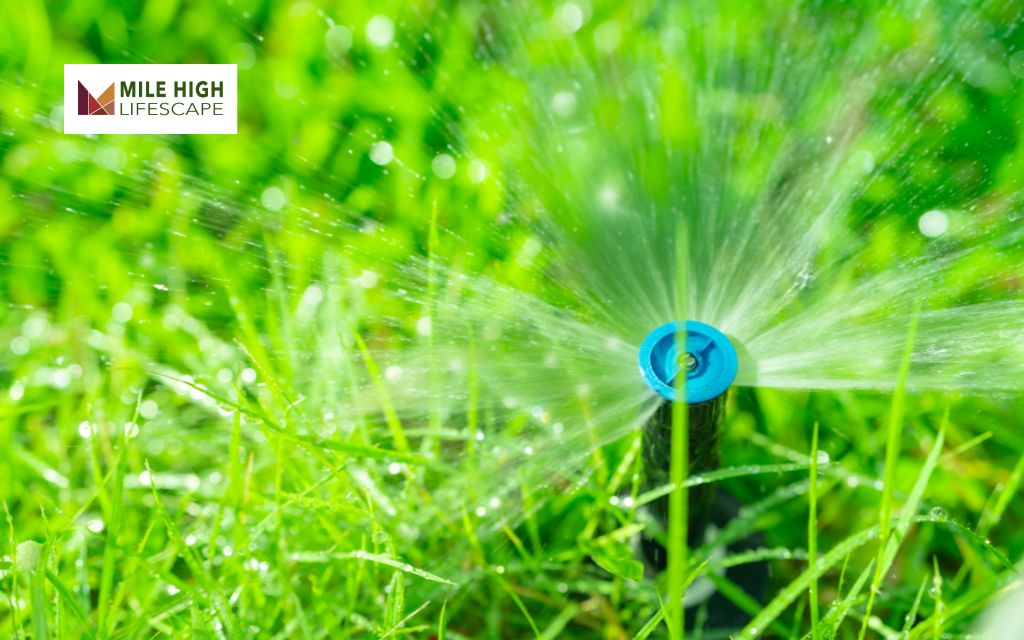
How Long Should You Water Your Lawn?
To find the best time to water lawn and make sure your grass gets the right amount of water, it’s helpful to know how much your sprinkler system delivers.
Typically, it takes about 30 minutes to give your lawn half an inch of water. To check how long it takes your sprinklers to reach that amount, you can do the tuna can test:
- Step 1: Place small containers, like empty tuna cans, in different spots around your lawn.
- Step 2: Turn on your sprinklers and set a timer for 30 minutes.
- Step 3: After 30 minutes, measure the water in each can with a ruler. Find the average amount of water in all the cans. This tells you how much water your sprinkler puts out in 30 minutes.
- Step 4: Adjust your watering time based on what you find. If the average is about half an inch, then 30 minutes of watering is just right. If it’s less than half an inch, you’ll need to water a little longer. If it’s more, turn the sprinklers off a bit sooner.
This simple test helps you know exactly how much water your lawn is getting and ensures it’s healthy and well-watered.
Tools and Techniques for Efficient Lawn Watering
Efficient lawn watering is essential for maintaining a healthy and vibrant yard. Utilizing the right tools and techniques can optimize water usage and promote robust grass growth.
Sprinkler Systems
Sprinklers are a great way to water your lawn, and there are different types for different needs:
- Oscillating Sprinklers: These move back and forth to cover rectangular areas, making them perfect for medium-sized lawns.
- Rotary Sprinklers: These have rotating arms and water in a circular pattern, which works well for larger lawns.
- Smart Irrigation Systems: These high-tech sprinklers adjust their watering schedule based on the weather, soil moisture, and plant needs, helping save water and time.
Using the right sprinkler system ensures water is spread evenly, reducing waste and helping your lawn stay healthy.
Soaker Hoses
Soaker hoses are special hoses that slowly release water directly into the soil. They work great for:
- Garden Beds: They provide consistent moisture to plant roots without wetting the leaves.
- Lawn Edges: They help water areas that traditional sprinklers might miss, like the edges of your lawn.
Setting up soaker hoses correctly can help you water more efficiently and keep your plants happy.
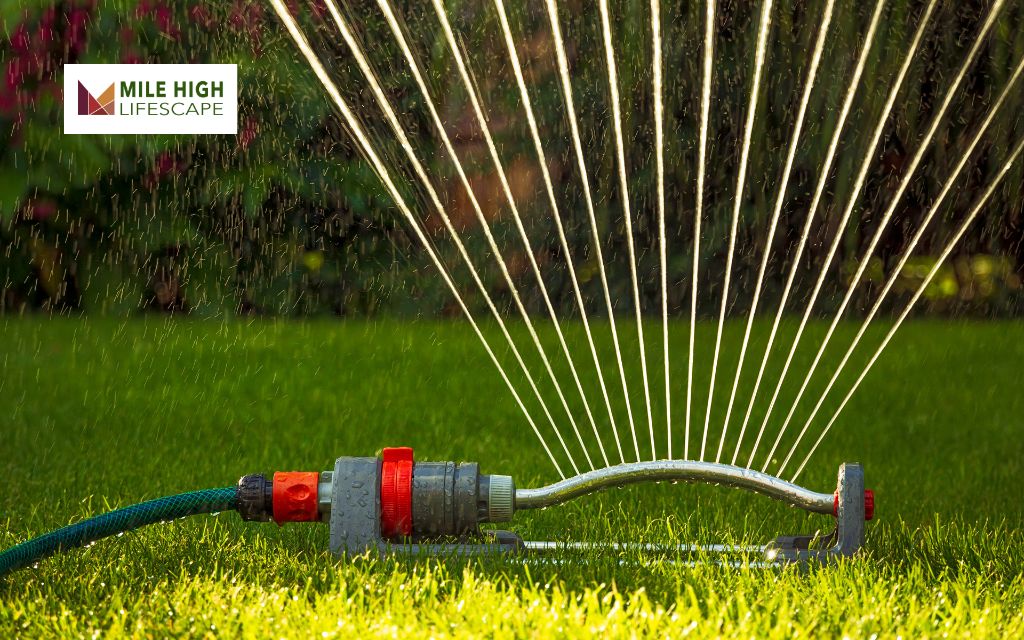
Smart Lawn Watering Apps
Tech-savvy homeowners can use smart watering apps like Rachio and Rain Bird to make lawn care easier. These apps offer features like:
- Weather Forecast Integration: They adjust the watering schedule based on the weather to prevent over or under-watering.
- Custom Alerts: These apps notify you when it’s time to adjust the watering schedule or if there’s a problem.
- Water Usage Monitoring: Track how much water you’re using to save money and conserve resources.
Using these apps can help you create a more efficient lawn watering schedule and keep your yard looking great!
Traditional Automatic Spray System
Traditional spray systems use pop-up sprinkler heads that can spray water in a full circle, half circle, or quarter circle. While they are convenient, these spray heads can be less efficient than other systems like rotor heads or drip irrigation. This is because they release water quickly, which can be too much for your soil to absorb, especially if you have clay soil.
To get the best coverage, it’s important to space the sprinkler heads so that each one sprays water all the way to the next one. This is called “head-to-head” coverage. Also, using heads from the same brand and model will help make sure the water is spread evenly across your lawn.
Rotor System
Rotor systems are usually more efficient than spray heads. They release water slowly, which gives your soil more time to absorb moisture.
In the past, rotors weren’t used much for smaller lawns, but now there are rotors made for smaller areas, with a water output of less than half an inch per hour and a reach of under 15 feet. You can adjust the application patterns and the reach of these rotors, making them perfect for lawns with tricky shapes.
Whether you’re using a traditional spray system or a rotor system, knowing the best time to water lawn is key to ensuring your lawn gets the right amount of moisture without wasting water.
Best Practices for Efficient Lawn Watering
Water According to Grass Maturity
New grass needs more water than established grass. For newly seeded cool-season lawns, make sure the top 1.5 inches of soil stays moist (but not soggy) for 5 to 10 days while the seeds are germinating. For warm-season grass, you may need to water the new seeds for up to 2-3 weeks, depending on the type of grass.
To water new grass, use a gentle spray or mist once or twice a day to avoid washing away the seeds. Be gentle and stick to a regular watering schedule to keep your lawn growing strong.
Water According to Season
The best time to water lawn depends on the season and weather. For example, during the rainy season, you’ll want to water less because your lawn gets moisture naturally. In a drought, your grass will need more water.
Temperature also plays a big role. In summer, cool-season grasses will need extra water to stay healthy because they struggle in the heat. But during early spring and late fall, you can water less since there’s less heat and sunlight, and the grass won’t dry out as quickly. Over-watering in cooler months can encourage fungus growth, so be careful.
Water According to Soil Type
Different soils need different watering schedules.
- Clay soils hold water for a long time, so you don’t want to overwater them. Water for 15 minutes at a time, more often, until your lawn gets 1 to 1.5 inches of water each week. This gives the soil time to absorb the water without causing runoff or puddling.
- Sandy soils don’t hold water well but drain quickly, so they need about ⅓ inch of water three times a week.
- Silty soils don’t hold water as well as clay but better than sand, so water them twice a week with ½ inch of water each time.
- Loamy soil is a great mix because it has the best of both worlds: it drains water like sand but also holds moisture like clay. Lawns with loamy soil typically need about ½ inch of water twice a week to stay healthy.
If you’re not sure what type of soil you have, you can get a soil test from your local extension office. It will tell you the texture of your soil and suggest any changes that can help improve it!
Water According to Grass Type
Best time to water lawn also depends on the type of grass you have. Whether you have cool-season or warm-season grass, knowing its needs can help you water properly.
Cool-season grasses, like Kentucky bluegrass and fescue, usually need 1 to 1.5 inches of water each week. It’s best to water them three times a week with equal amounts. During hot summer months, they might need extra water to stay healthy. Some examples of cool-season grass are:
- Kentucky bluegrass
- Fine fescue
- Tall fescue
- Perennial ryegrass
- Bentgrass
Warm-season grasses, like Bermudagrass and Zoysiagrass, need less water—about ½ inch to 1 inch weekly. Water them once or twice a week. Some warm-season grasses include:
- Bermudagrass
- St. Augustinegrass
- Zoysiagrass
- Centipedegrass
- Bahiagrass
- Buffalograss
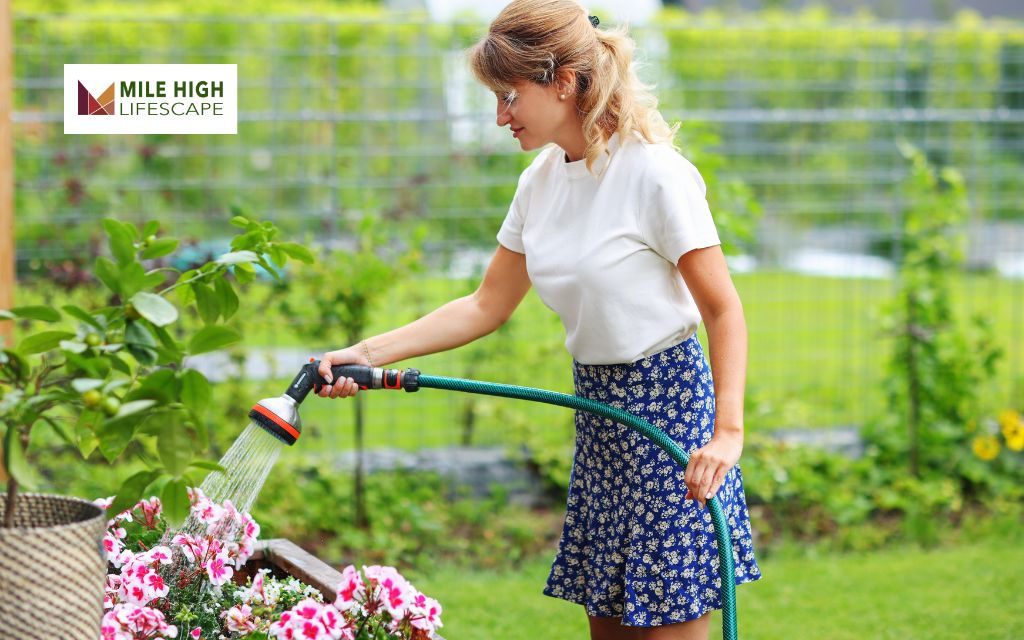
FAQs about Best Time To Water Lawn
What is the best time of day to water your grass?
The best time to water lawn is early in the morning, between 5 a.m. and 9 a.m. This allows the water to soak into the soil before the sun makes it evaporate. Watering in the evening can leave the grass wet all night, which could lead to mold or other lawn problems.
What is the cheapest time to water your lawn?
Watering in the early morning or late evening is usually cheaper, especially in places where utility companies charge more during the day. Early morning is still the best time to water lawn to keep it healthy and avoid disease.
What is the best time of day to water plants?
Just like with lawns, the best time to water lawn and your plants is early in the morning. This helps the water reach the roots, and the leaves can dry out during the day, which helps stop fungal growth.
What is the best time to mow the lawn?
The best time to mow your lawn is in the late morning, between 8 a.m. and 10 a.m. By this time, the morning dew has dried, and the grass isn’t stressed from the heat. Mowing when it’s too hot can harm the grass, and mowing in the evening doesn’t give the grass enough time to recover before night.
Conclusion
Knowing the best time to water lawn helps you maintain a strong, green, and healthy yard. Watering early in the morning is best to prevent water loss and lawn diseases. Water deeply but less often, adjust based on your grass type, and use the right tools for efficient watering. With smart habits and these simple tips, your lawn will stay beautiful all year. Need expert help? Mile High Lifescape is here to keep your lawn looking its best!
